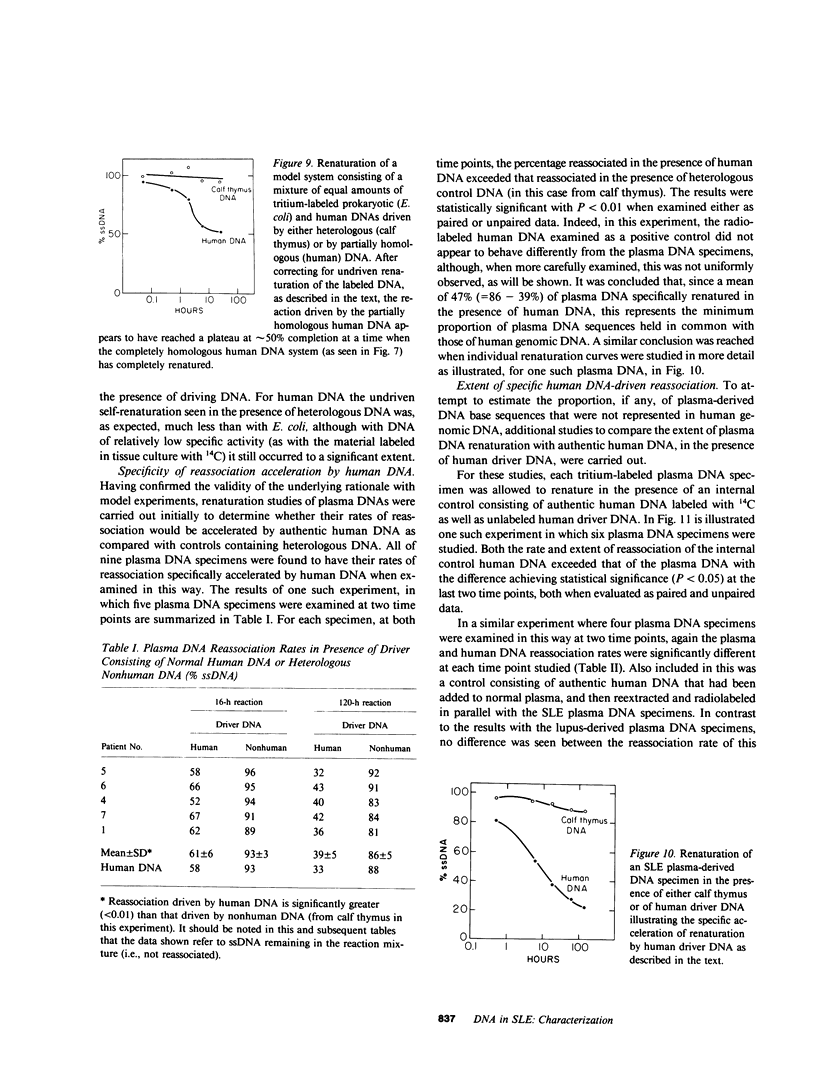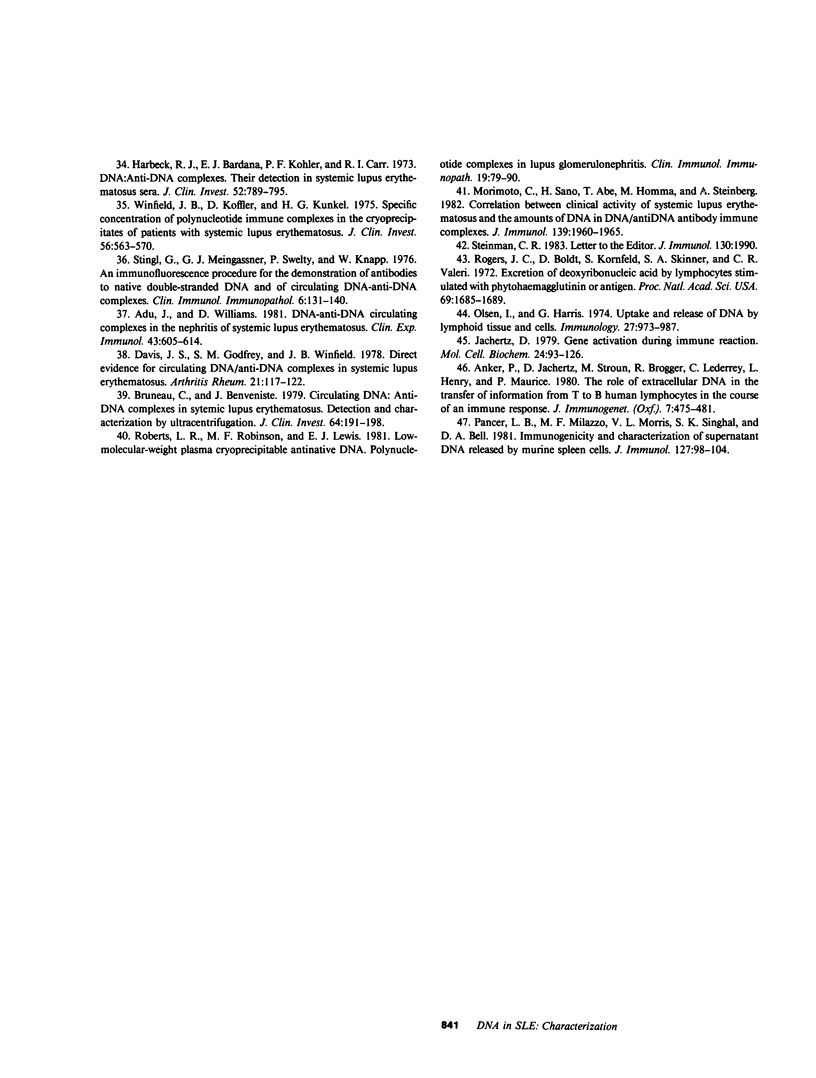Abstract
Immunoprecipitable double-stranded (dsDNA) was previously shown to persist in the circulation of a clinically recognizable subgroup of patients with systemic lupus erythematosus (SLE). Plasma from 10 such patients was subjected to a DNA isolation procedure that used a combination of proteolysis, phenol extraction, and hydroxylapatite adsorption and elution in the presence of urea. The isolated dsDNA was radiolabeled by nick translation and then characterized by isopyknic ultracentrifugation in CsCl under both neutral and alkaline conditions, as well as after digestion with S1-endonuclease. These experiments demonstrated essential identity in nucleotide base composition between the plasma-derived DNA and human genomic DNA. The presence of specific human base sequences in the plasma DNA was demonstrated by finding that authentic human genomic DNA accelerated the renaturation of plasma DNA when compared with the effect of nonhuman, control DNA. The proportion of such sequences in plasma DNA was estimated by attempting to renature the plasma DNA in the presence of human DNA under conditions shown to result in complete renaturation of human DNA in model experiments. In this way, a minimum of 47% of plasma DNA base sequences could be shown also to be present in human genomic DNA. However, an average of 10-20% of the plasma-derived DNA failed to renature under these conditions, a result that was further confirmed by comparing the renaturation of the tritium-labeled plasma DNA specimens, in double-label experiments, with internal controls consisting of 14C-labeled authentic human DNA. Attempts to drive the reaction to completion with human DNA led to a similar conclusion. The relative nonrenaturability of this fraction of plasma DNA did not appear to be attributable to extensive chain breakage, although adequate analysis of this DNA subfraction was limited by reagent availability. It was therefore concluded that, in this group of SLE patients, persistently circulating DNA consisted largely of base sequences also found in human genomic DNA. The additional presence in plasma of a DNA subfraction that differed in its renaturation behavior from human genomic DNA was recognized, although its significance could not be established with certainty.
Full text
PDF









Selected References
These references are in PubMed. This may not be the complete list of references from this article.
- Adu D., Dobson J., Williams D. G. DNA-anti-DNA circulating complexes in the nephritis of systemic lupus erythematosus. Clin Exp Immunol. 1981 Mar;43(3):605–614. [PMC free article] [PubMed] [Google Scholar]
- Anker P., Jachertz D., Stroun M., Brögger R., Lederrey C., Henri J., Maurice P. A. The role of extracellular DNA in the transfer of information from T to B human lymphocytes in the course of an immune response. J Immunogenet. 1980 Dec;7(6):475–481. doi: 10.1111/j.1744-313x.1980.tb00742.x. [DOI] [PubMed] [Google Scholar]
- Britten R. J., Graham D. E., Neufeld B. R. Analysis of repeating DNA sequences by reassociation. Methods Enzymol. 1974;29:363–418. doi: 10.1016/0076-6879(74)29033-5. [DOI] [PubMed] [Google Scholar]
- Bruneau C., Benveniste J. Circulating DNA:anti-DNA complexes in systemic lupus erythematosus. Detection and characterization by ultracentrifugation. J Clin Invest. 1979 Jul;64(1):191–198. doi: 10.1172/JCI109439. [DOI] [PMC free article] [PubMed] [Google Scholar]
- Davis G. L., Jr, Davis J. S., 4th Detection of circulating DNA by counterimmunoelectrophoresis (CIE). Arthritis Rheum. 1973 Jan-Feb;16(1):52–58. doi: 10.1002/art.1780160108. [DOI] [PubMed] [Google Scholar]
- Dennin R. H. DNA of free and complexed origin in human plasma: concentration and length distribution. Klin Wochenschr. 1979 May 3;57(9):451–456. doi: 10.1007/BF01477498. [DOI] [PubMed] [Google Scholar]
- Gocke D. J., Hsu K., Morgan C., Bombardieri S., Lockshin M., Christian C. L. Association between polyarteritis and Australia antigen. Lancet. 1970 Dec 5;2(7684):1149–1153. doi: 10.1016/s0140-6736(70)90339-9. [DOI] [PubMed] [Google Scholar]
- Harbeck R. J., Bardana E. J., Kohler P. F., Carr R. I. DNA:anti-DNA complexes: their detection in systemic lupus erythematosus sera. J Clin Invest. 1973 Apr;52(4):789–795. doi: 10.1172/JCI107242. [DOI] [PMC free article] [PubMed] [Google Scholar]
- Harbeck R. J., Hoffman A. A., Carr R. I., Bardana E. J. Measurement of DNA/anti-DNA complexes. Scand J Rheumatol Suppl. 1975;11:26–34. doi: 10.3109/03009747509095626. [DOI] [PubMed] [Google Scholar]
- Harbeck R. J., Hoffmann A. A., Carr R. I. Studies on the nature of circulating DNA in systemic lupus erythematosus (SLE). J Rheumatol. 1975 Jun;2(2):194–203. [PubMed] [Google Scholar]
- Hughes G. R., Cohen S. A., Lightfoot R. W., Jr, Meltzer J. I., Christian C. L. The release of DNA into serum and synovial fluid. Arthritis Rheum. 1971 Mar-Apr;14(2):259–266. doi: 10.1002/art.1780140211. [DOI] [PubMed] [Google Scholar]
- Hung P. P., Mao J. C., Ling C. M., Overby L. R. Hybridisation of Dane particle DNA with the free plasma DNA of hepatitis carriers. Nature. 1975 Feb 13;253(5492):571–572. doi: 10.1038/253571a0. [DOI] [PubMed] [Google Scholar]
- Jachertz D. Gene activation during immune reaction. Mol Cell Biochem. 1979 Mar 19;24(2):93–126. doi: 10.1007/BF00314890. [DOI] [PubMed] [Google Scholar]
- Kamm R. C., Smith A. G. Nucleic acid concentrations in normal human plasma. Clin Chem. 1972 Jun;18(6):519–522. [PubMed] [Google Scholar]
- Kaznacheev V. P., Poliakov Ia V. Issledovanie nekotorykh pokazatelei nukleinovogo obmena u bol'nykh aterosklerozom. Kardiologiia. 1967 Jul;7(7):22–25. [PubMed] [Google Scholar]
- Kohne D. E., Levison S. A., Byers M. J. Room temperature method for increasing the rate of DNA reassociation by many thousandfold: the phenol emulsion reassociation technique. Biochemistry. 1977 Nov 29;16(24):5329–5341. doi: 10.1021/bi00643a026. [DOI] [PubMed] [Google Scholar]
- Lippmann M. L., Morgan L., Fein A., Shapiro B., Leon S. A. Plasma and serum concentrations of DNA in pulmonary thromboembolism. Am Rev Respir Dis. 1982 Apr;125(4):416–419. doi: 10.1164/arrd.1982.125.4.416. [DOI] [PubMed] [Google Scholar]
- Maniatis T., Jeffrey A., Kleid D. G. Nucleotide sequence of the rightward operator of phage lambda. Proc Natl Acad Sci U S A. 1975 Mar;72(3):1184–1188. doi: 10.1073/pnas.72.3.1184. [DOI] [PMC free article] [PubMed] [Google Scholar]
- Morimoto C., Sano H., Abe T., Homma M., Steinberg A. D. Correlation between clinical activity of systemic lupus erythematosus and the amounts of DNA in DNA/anti-DNA antibody immune complexes. J Immunol. 1982 Nov;129(5):1960–1965. [PubMed] [Google Scholar]
- Olsen I., Harris G. Uptake and release of DNA by lymphoid tissue and cells. Immunology. 1974 Dec;27(6):973–987. [PMC free article] [PubMed] [Google Scholar]
- Pancer L. B., Milazzo M. F., Morris V. L., Singhal S. K., Bell D. A. Immunogenicity and characterization of supernatant DNA released by murine spleen cells. J Immunol. 1981 Jul;127(1):98–104. [PubMed] [Google Scholar]
- Phillips P. E. The virus hypothesis in systemic lupus erythematosus. Ann Intern Med. 1975 Nov;83(5):709–715. doi: 10.7326/0003-4819-83-5-709. [DOI] [PubMed] [Google Scholar]
- Raptis L., Menard H. A. Quantitation and characterization of plasma DNA in normals and patients with systemic lupus erythematosus. J Clin Invest. 1980 Dec;66(6):1391–1399. doi: 10.1172/JCI109992. [DOI] [PMC free article] [PubMed] [Google Scholar]
- Rigby P. W., Dieckmann M., Rhodes C., Berg P. Labeling deoxyribonucleic acid to high specific activity in vitro by nick translation with DNA polymerase I. J Mol Biol. 1977 Jun 15;113(1):237–251. doi: 10.1016/0022-2836(77)90052-3. [DOI] [PubMed] [Google Scholar]
- Roberts J. L., Robinson M. F., Lewis E. J. Low-molecular-weight plasma cryoprecipitable antinative DNA: polynucleotide complexes in lupus glomerulonephritis. Clin Immunol Immunopathol. 1981 Apr;19(1):75–90. doi: 10.1016/0090-1229(81)90049-0. [DOI] [PubMed] [Google Scholar]
- Rogers J. C., Boldt D., Kornfeld S., Skinner A., Valeri C. R. Excretion of deoxyribonucleic acid by lymphocytes stimulated with phytohemagglutinin or antigen. Proc Natl Acad Sci U S A. 1972 Jul;69(7):1685–1689. doi: 10.1073/pnas.69.7.1685. [DOI] [PMC free article] [PubMed] [Google Scholar]
- Sano H., Morimoto C. Dna isolated from DNA/anti-DNA antibody immune complexes in systemic lupus erythematosus is rich in guanine-cytosine content. J Immunol. 1982 Mar;128(3):1341–1345. [PubMed] [Google Scholar]
- Sano H., Morimoto C. Isolation of DNA from DNA/anti-DNA antibody immune complexes in systemic lupus erythematosus. J Immunol. 1981 Feb;126(2):538–539. [PubMed] [Google Scholar]
- Sipes J. N., Suratt P. M., Teates C. D., Barada F. A., Davis J. S., Tegtmeyer C. J. A prospective study of plasma DNA in the diagnosis of pulmonary embolism. Am Rev Respir Dis. 1978 Sep;118(3):475–478. doi: 10.1164/arrd.1978.118.3.475. [DOI] [PubMed] [Google Scholar]
- Steinman C. R., Ackad A. Appearance of circulating DNA during hemodialysis. Am J Med. 1977 May;62(5):693–697. doi: 10.1016/0002-9343(77)90872-5. [DOI] [PubMed] [Google Scholar]
- Steinman C. R. Circulating DNA in systemic lupus erythematosus. Association with central nervous system involvement and systemic vasculitis. Am J Med. 1979 Sep;67(3):429–435. doi: 10.1016/0002-9343(79)90789-7. [DOI] [PubMed] [Google Scholar]
- Steinman C. R. Circulating DNA-containing immune complexes in SLE. J Immunol. 1983 Apr;130(4):1990–1991. [PubMed] [Google Scholar]
- Steinman C. R. Detection and semiquantitation of DNA by counterimmunoelectrophoresis (CIE). Methods Enzymol. 1982;84:187–193. doi: 10.1016/0076-6879(82)84016-0. [DOI] [PubMed] [Google Scholar]
- Steinman C. R. Free DNA in serum and plasma from normal adults. J Clin Invest. 1975 Aug;56(2):512–515. doi: 10.1172/JCI108118. [DOI] [PMC free article] [PubMed] [Google Scholar]
- Steinman C. R. Quantitation of submicrogram concentrations of DNA by a modified Laurell electrophoresis method. J Immunol Methods. 1979;31(3-4):373–378. doi: 10.1016/0022-1759(79)90151-0. [DOI] [PubMed] [Google Scholar]
- Steinman C. R. Use of nucleic acid hybridization for specific detection of submicrogram quantities of DNA, and its application to human plasma. Clin Chem. 1975 Mar;21(3):407–411. [PubMed] [Google Scholar]
- Stingl G., Meingassner J. G., Swelty P., Knapp W. An immunofluorescence procedure for the demonstration of antibodies to native, double-stranded DNA and of circulating DNA-anti-DNA complexes. Clin Immunol Immunopathol. 1976 Sep;6(2):131–140. doi: 10.1016/0090-1229(76)90103-3. [DOI] [PubMed] [Google Scholar]
- Winfield J. B., Koffler D., Kunkel H. G. Specific concentration of polynucleotide immune complexes in the cryoprecipitates of patients with systemic lupus erythematosus. J Clin Invest. 1975 Sep;56(3):563–570. doi: 10.1172/JCI108125. [DOI] [PMC free article] [PubMed] [Google Scholar]


